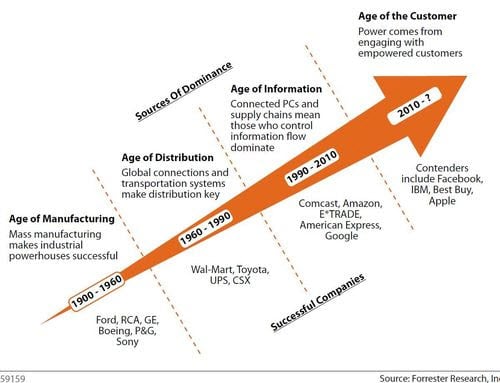B2B Marketing: Forrester on Becoming a Customer Obsessed Company
June 9, 2011

Leading research firm Forrester recently published a new report on “Competing in the Age of the Customer”. Although the majority of the examples they cite are from B2C, their conclusions have profound consequences for any B2B focused organisation. Here’s why...
Let’s start by defining what Forrester mean by “The Age of the Customer” - the fourth and most recent shift in the forces that drive competitive advantage. They draw comparisons to the three previous ages, which they identify as The Age of Manufacturing, the Age of Distribution, and the Age of Information.

The transition from the Age of Information to the Age of the Customer is a particularly interesting one, because although both are founded on information power, in the former case information power lay in the hands of corporations - but in today’s environment information power lies firmly in the hands of your prospects and customers.
How much your company truly knows and about your customers and prospects and how effectively you engage with them has become the primary determinant of whether your organisation will expire, survive or thrive.
The winners - Forrester refers to them as Customer Obsessed - are the ones that take advantage of every means possible to identify and engage with their most valuable prospects and customers, understand what really matters to them, understand how they prefer to consume information, and to understand how and why they choose to buy.
Forrester offered four prescriptions. Here’s my take on what they mean for B2B focused organisations who are determined to thrive in the Age of the Customer:
1: Change the way you do Research
Start by trying to answer the right question. Traditional “what feature should we build” research isn’t going to help you develop a more relevant offering in the Age of the Customer. The more relevant questions are “what problems do we need to solve”, “what are the common characteristics of our most valuable customers and prospects”, and “how and why do they make buying decisions”.
Traditional research methodologies aren’t very helpful. In the age of the customer, qualitative insights are far more valuable than quantitative surveys, and this means using interactive media. You want conversations, not check boxes. You need to identify unarticulated needs. And you need to tune in to the topics that are most engaging people in business social networks.
2: Change the way you Service your customers
Every customer interaction offers an opportunity to learn, to build trust, and to enhance your reputation. A recent study by the American Marketing Association concluded that the quality of interaction with customer-facing staff had a far bigger impact on brand and reputation than all of the conventional marketing tools combined.
The investment involved in equipping and empowering your customer-facing staff to have better conversations with your customers and prospects and to look beyond the immediate issue and think about how they might better serve them (and what else they might learn from them) is trivial compared to the benefits you will generate.
3: Change the way you Sell
Whenever I conduct voice of the customer conversations on behalf of clients with recent customers and prospects in order to better understand how and why they choose to buy, one message comes through loud and clear. They tell me “as long as I feel that I am learning something, I’m listening. But the moment I feel like I’m on the receiving end of a sales pitch, I switch off”.
In an age in which information power is firmly in the hands of the customer, the role of the B2B sales person has changed. Your sales people are no longer just educators - they need to become interpreters, using their experience to help their prospects evaluate the wealth of information available to them, to enable them to cut through the clutter, and to make sense of a complex world.
4: Change the way you Market
As in B2C, the centre of gravity of B2B marketing is clearly shifting from old-fashioned broadcasting to new-fangled engagement and from “listen to me” to “I want to talk with you” - although not always quickly enough. You can accelerate the transformation by paying attention to context and content.
Context is about going beyond defining your target audience through traditional demographics to identifying with their situational, environmental and behavioural characteristics - and understanding who they turn to for advice, and how and why they make buying decisions.
Content is about offering information that is interesting, relevant and valuable to them. Information that stimulates and intrigues them, and which makes them want to learn more. Great content - and a provocative and pertinent point-of-view - is the essential foundation for effective engagement.
Are You Sufficiently Obsessed?
So - by the four tests above, could you genuinely describe your organisation today as being customer obsessed? And what would happen if a competitor came along who did a better job of it?


Comments